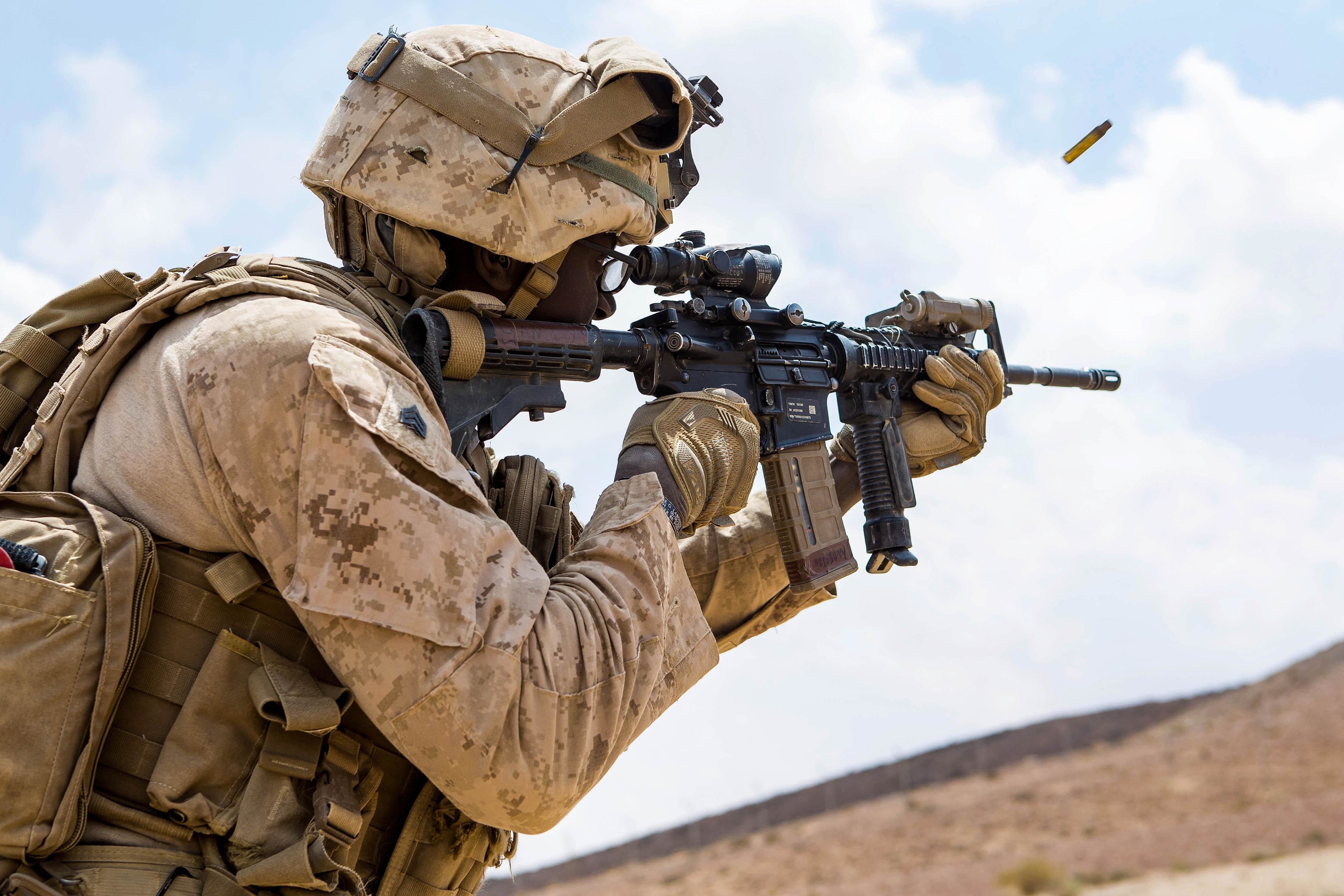A disappointingly low completion rate for the infantry squad leader course is prompting the Marine Corps to throw big cash bonuses at today’s grunts in the hopes of retaining them as experienced corporals and sergeants.
It’s been about three years since the Corps established a new job field for squad leaders — the 0365 military occupational specialty — which only 359 Marines have obtained, according to data provided by Marine Corps Training and Education Command. The figure is barely half the number needed to fill out the 648 active-duty rifle squads across the Corps.
Roughly 706 corporals and sergeants have graduated the ISULC course since 2015, according to TECOM.
While that reflects some progress for the Corps and its effort to further professionalize the infantry’s leadership, the total attendance at the schools remains less than half the available qualified corporals and sergeants who could potentially attend.
RELATED

Those numbers are as “disappointingly low,” according to Robert Scales, the retired Army major general who is leading the Pentagon’s task force on close-combat lethality, a major initiative for Defense Secretary Jim Mattis’ Pentagon.
The Corps hopes those ISULC graduates will beef up the lethality of its new 12-man rifle squad model and help build a more mature and tech-adept force. But the dismaying figures portend a difficult path ahead for the Corps as it seeks to retool its forces for a modern battlefield.
The six-week course hones Marines’ skills in decision-making and leadership at the tactical level. It provides the Corps’ junior leaders with education and advanced training that should propel them to become successful squad leaders.
The course is a key part of the pipeline for those Marines wishing to don the 0365 MOS, which starts with Marines being approved for the Corps’ Squad Leader Development Program and also the completion of the sergeants course.
To fill the gap and entice more Marines to go to the school and move into the 0365 job field, the Corps is pushing new initiatives and bonuses as high as $70,000 to entice its most competent junior enlisted noncommissioned officers stay in the Corps and move into the squad-leader MOS. Some bonuses may also be available for Marines who have already graduated the six-week ISULC course.
The Corps’ fiscal year 2019 bonuses include three initiatives with flexible re-enlistment options that are focused at the heart of the Corps’ primary function, ground combat and the junior rank and file Marines who bear the responsibility to close with and destroy the enemy by fire and maneuver.
Those retention efforts are aimed at “corporals and sergeants who have completed or will commit to completing Infantry Small Unit Leader Course and have between 5 to 7 years of time in service,” said Yvonne Carlock, a spokeswoman for Manpower and Reserve Affairs.
The Squad Leader Development Program includes a $30,000 bonus for 36-48-month contracts, and those qualified for the program are also eligible for the 72-month lateral move kicker of $40,000, potentially netting a Marine $70,000. Marines must intend or already have completed ISULC.
The Squad Leader OpFor Kicker comes with a $20,000 bonus and 48-month contract and targets those Marines who are ISULC complete or intend to complete the training. Marines must be willing to remain in the infantry battalions for 24 months.
And the 24-Month Qualified Rifle Squad Leader Initiative can net a Marine $10,000. This program is for infantry riflemen who have completed the ISULC and agree to remain on station with an infantry battalion.
The bonuses may indicate a retention issue in the Marine Corps among its skilled infantry leaders. Other big bonuses dished out by the Corps have been used to plug other manpower gaps.

Just recently, the Corps pushed out its new aviation bonuses that can net qualified pilots over $200,000. The Corps, like the Air Force, has been faced with a pilot shortage and steep competition from commercial airlines that are enticing Marine pilots with fat bonuses and hefty paychecks.
The Corps argues that bonuses have had some success in the past in plugging retention gaps and that the bonuses exist to influence a decision.
Marine Corps Times requested data regarding the retention of Marines in the 0365 MOS and those who have completed the ISULC course. But was provided the number of submitted packages for extension or re-enlistment.
According to Manpower and Reserve Affairs, 440 Marines been approved for either re-enlistment with a lateral move or extension with lateral move since FY15 through FY18 to date.
Those figures don’t show how many of those are in the 0365 MOS or have completed the ISULC course and who have decided to stay in the Corps.
The shortage of squad leaders willing to stay in the Corps is fueling some concern about whether the Marines are retaining its best infantrymen.
“The Corps should take a candid look at why they have difficulty retaining the kind of high-potential Marines they want filling the 0365 billets,” said Nick Vaughan, a former Marine squad leader who served in Iraq. “Older and more seasoned forces are certainly more lethal, but a move toward that more lethal force should start with a dedicated effort to find out why the current Marines with valuable experience can’t be retained.”
There are several reasons why Marines may not be not volunteering to take the squad-leaders course, which is available at Camp Lejeune, North Carolina.
It’s not a requirement, as infantry Marines can move into squad leader roles without taking the course or officially joining the official 0365 MOS.
In fact, some Marines argue the course really isn’t necessary.
“They [squad leaders] should be learning those skills already, OJT [on-the-job training], so a lance corporal-sergeant squad leader may be doing the job already, so what is the point of attending the course? Especially if you may lose that position as soon as someone senior checks in to the platoon?” said a former infantry platoon commander who served in Afghanistan.
Also, it can be difficult to meet all the requirements for the course, for example, not being the correct rank because cutting scores are high.
And getting into the course often requires mundane training that lowers morale, according to former platoon commanders and squad leaders.
“Additionally, some units/leaders don’t give their Marines the permission or time to attend those courses,” the former infantry platoon commander added.
Modernizing the infantry
The Corps’ effort to transform its infantry comes at a time when the combat arms are getting high-level attention at the Pentagon.
Many recent changes, like new weapons and bonuses for grunts, are driven by Mattis’ task force on close-combat lethality, which is spearheaded by Scales.
Scales chairs the task force and is also the author of “Scales on War: The Future of America’s Military at Risk.” His book lays the foundation for many of the task force’s recommendations.
And if the Corps follows them, it may fundamentally alter the make-up and organization of grunts with an older force.
Scales believes the combat arms have been neglected for far too long. The Marine Corps and the Army have offered only minimal resources and tech invested into the military’s front-line troops, he said. More broadly, the military should focus more on manning the right people while also removing wasteful training, he says.
“The irony is, those who do most of the killing and dying in our wars are those who, back in the day, received the fewest resources,” Scales said. “We need to put resources toward that.”
And the Corps has done just that over the past couple of years. Commandant Gen. Robert B. Neller has been dishing out all kinds of new goodies and tech to boost combat lethality to include new M27 Infantry Automatic Rifles, the M320 grenade launcher as well as tablets and drones to enhance battlefield situational awareness.
The Corps is in the beginning stages of testing low-cut, Ops-Core-like helmets typically worn by elite Marine special operators. The low-cut helmets work well with headset devices like Peltors, which improve battlefield communication and give better hearing protection.

“The Marines have passionately embraced this,” Scales said about the combat task force. “Gen. Neller has been remarkably enthusiastic in transforming how the Marine Corps fights.”
But manning, retaining and training critical talent in the junior enlisted NCO corps also is vitally important.
“The majority of that wasn’t in technology, it was in the human factor,” Scales said about boosting combat-unit lethality “Chief among them was manning, selection and of course training.”
Data compiled over the years clearly shows that the best performing combat units are ones stacked with older and more mature Marines and soldiers, and the key age for close combat is mid- to late twenties, Scales said.
For the Corps, where nearly 60 percent of the force is under the age of 25, it’s vital to retain the best corporals and sergeants in combat units.
The critical command point is not at the platoon commander or lieutenant level but with sergeants at the squad level, Scales says.
But with the Corps’ focus on a four-year enlistment, it creates added hurdles. “The majority of them leave at the end of four years,” Scales said.
“We got to fix this, we got to close this gap,” senior leaders told Scales, he says.
Bonuses are one way to bridge the gap, but so is training. The combat task force wants to reduce wasteful training.
Scales recommends bridging the training gap with technology, simulators and immersion training.
The incentives being pushed by the Corps and its ability to retain and train ISULC-capable squad leaders is also an important component of Neller’s recent decision to reduce the infantry rifle squad to a 12-man team.
The Corps argues its new 12-man squad model will increase lethality despite the loss of a Marine. Part of that assumption lies in the Corps’ plan to man the new squad at 12 all the time and ensuring ISULC-trained squad leaders arrive at units a full year prior to a deployment, according to spokeswoman Capt. Ryan Alvis.
Shawn Snow is the senior reporter for Marine Corps Times and a Marine Corps veteran.










